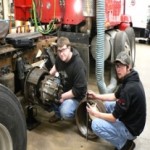Service technicians and mechanics are required positiions in this field. Technicians can plug diagnostic computers into onboard computers to diagnose components needing adjustments or repairs.
Technicians use a variety of tools in their work: power tools, such as pneumatic wrenches to remove bolts quickly; machine tools, like lathes and grinding machines, to rebuild brakes; welding and flame-cutting equipment to remove and repair exhaust systems; and jacks and hoists to lift and move large parts. Service technicians also use common hand tools—screwdrivers, pliers, and wrenches—to work on small parts and to get at hard-to-reach places. They may use a variety of computerized testing equipment to pinpoint and analyze malfunctions in electrical systems and other essential systems. Tachometers and dynamometers, for example, serve to locate engine malfunctions. Service technicians also use ohmmeters, ammeters, and voltmeters when working on electrical systems. Employers typically furnish expensive power tools, computerized engine analyzers, and other diagnostic equipment, but hand tools are normally accumulated with experience, and many experienced technicians have thousands of dollars invested in them.



